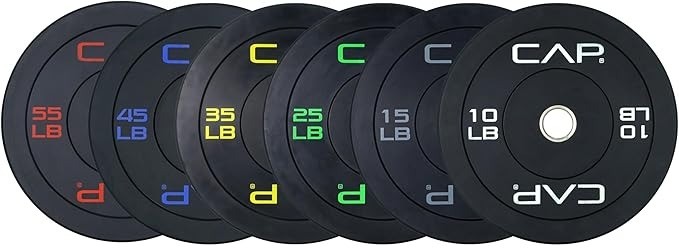Everything you need to know about Weight Plates - Buying Guide
Shopping for weight plates? This complete buying guide breaks down types, materials, sizes, and what to avoid—so you can build your perfect home gym or stock up smart for commercial use. Know what you’re lifting before you buy.


Before you place your next bulk order, here’s what every procurement manager needs to know about choosing—and selling—high-quality bumper plates. From understanding regional manufacturing hubs to material choices, hub construction, and common pitfalls, this guide will help you stock products your buyers will trust and reorder.
1. Why Bumper Plates Matter
Commercial and home-studio operators rely on bumper plates to protect floors, reduce noise, and ensure bar longevity—cast-iron plates simply can’t handle repeated drops . Quality bumpers also maintain consistent diameter across weights, guaranteeing proper lift mechanics every time .
The average fitness enthusiast starts with 12 plates, then adds more as they outgrow their initial loads. You can upsell heavier bumper plates or fractional sets later, but 12 plates covers about 90 % of home-gym needs
3. Types of Bumper Plates
Function-Based Categories
Training Bumpers: Thick rubber over steel hubs—robust but slightly higher bounce; cost-efficient for general use .
Competition Bumpers: IWF-certified, ±10 g weight tolerance, thinner profile for max loading capacity .
Technique Plates: Light polyethylene models (2.5–5 kg) for form practice and rehab .
Fractional & Change Plates: Micro-increment (0.125–1 kg) add-ons for precision loading without collars .
Key Specs Across All Bumpers
Diameter: Standard 450 mm per IWF rules .
Hub ID: 50.4 mm to fit Olympic-sleeve barbells .
Thickness: Increases with weight; lets you load heavier plates without changing lift height .
5. Build Quality & Testing
Steel Hubs: Grade-45 stainless or hard-chrome hubs for corrosion resistance and tight tolerances .
Durometer (Shore A): Aim for 90–95 A for minimal bounce with acceptable noise levels .
Drop Testing:
Some plates withstand 12,000 drops from 8 ft without damage .
Others verify 30,000 drops from 9 ft with no insert deformation .
4. Material Matters
Virgin vs. Recycled Rubber
Virgin Rubber: Dense, low-bounce, mild odor—ideal for high-traffic gyms .
Crumb/Recycled Rubber: Softer, cost-effective, eco-friendly—but higher bounce and potential odor from adhesives.
Urethane
Benefits: Ultra-low bounce, no odor, vivid colors, and long lifespan—perfect for premium lines .
2. Location of Bumper-Plate Manufacturers
China dominates production—each region has its specialty:
Qingdao: High-volume rubber bumpers with solid quality control .
Nantong: Urethane plates with ultra-low bounce and vibrant color options .
Xiamen: Premium, tightly-toleranced competition plates for serious lifters .
6. Print, Color & Ergonomics
IWF Color Coding: Red 25 kg, Blue 20 kg, Yellow 15 kg, Green 10 kg, White 5 kg—quick visual load checks .
Lettering: Raised lettering outlasts printed ink—choose embossed logos for longevity .
Tapered Edges & Lips: Facilitate safe pick-up and protect hubs during accidental floor contact .
7. Buying Tips & Pitfalls to Avoid
Material Quality: Always pick plates made from virgin urethane or solid rubber over an iron core; cheaper plates often use impure urethane or inferior recycled rubber that degrades quickly .
Weight Accuracy: Look for plates with weight variances no greater than ±3% of stated weight—anything wider leads to inconsistent loading and imprecise training.
Warranty Coverage: Opt for plates that include at least a one-year warranty (many premium brands offer 3–5 years) to ensure manufacturer confidence in durability.
Standard Dimensions: Verify plates are 450 mm ± 2 mm in diameter with a 50.4 mm collar opening to comply with IWF specs and fit Olympic sleeves perfectly .
IWF Color Coding: Confirm that each plate’s weight matches the official IWF color (red = 25 kg, blue = 20 kg, etc.) and that coloring is uniform to avoid confusion in multi-user settings .
Raised Lettering: Choose plates with embossed or debossed lettering instead of ink-printed logos, which resist fading under heavy use .
Steel or Stainless Hubs: Prefer plates with grade-45 steel or stainless-steel hubs, ideally plated (chrome or zinc) for corrosion resistance and a snug fit on bars .
Drop-Test Data: Review manufacturer drop-test results—reputable bumpers endure 30,000 drops from 2.2 m for hi-temp models, 20,000 for competition, and 10,000 for training .
Use this checklist when sourcing bumper plates to ensure reliability, longevity, and buyer confidence, no surprises, just solid ROI.
8. Tailored Wholesale Packages
Maviet Supplies bundles to suit any buyer:
Training Sets: 10–25 kg plates in black or IWF colors, ideal for multi-gym installations, retail sales and home grade fitness standard.
Competition Packs: Calibrated 10 kg & 15 kg plates for event-ready studios.
Accessory Add-Ons: Fractional plates, technique plates, and plate racks for complete solutions.


